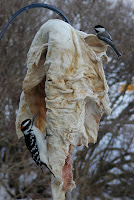Probably the most overlooked ingredient to a complete feeders station is grit. When reminded, everyone remembers their high school biology, birds don’t have teeth, they need grit to grind food in their gizzards. You may be supplying grit without realizing it, if you use sand on the drive way or side walk, instead of just salt, birds will no doubt pick up enough grit there. When there is icy snow cover and natural grit sources are buried, the Department of Highways is spreading a huge supply, the problem is, it’s right down the middle of the highway, not the safest place for birds to drop in for this necessity.
The finch species seem to be especially drawn to this salty sand, I’ve seen Pine Grosbeak, Red Crossbills, White-winged Crossbills, Evening Grosbeak, Pine Siskins, Redpoll, and Goldfinch; but other species are on the road to pick up grit. At home in PEI the Snow Bunting are thick on the road, the way they pick up in front of a car and land behind it reminds me of those aerodynamics-testing wind tunnels you see on car commercials. Many of these road side foragers don’t make it, I remember a few years ago, a friend was collecting several dead Pine Grosbeak every trip to Moncton.
I’ve tried several types of grit and haven’t found one to work any better than the other. I bought chicken grit from the feed store, since it was a supply of calcium I thought it might be a double whammy and attract even more birds. I tried egg shells, thinking that since Jays and Crows are blamed for robbing nests for the calcium found in egg shells, they would flock to the offering. I collected egg shells, (I mean a lot, I got one of the breakfast people at the Market to save a 5 gallon bucket full every week), these were lightly toasted and crushed into smaller pieces as per the directions in a bird feeding guide I read somewhere. I put them on a platform feeder and spread them on the ground away from other grit so I could witness the frenzy of birds that would be attracted. The results were underwhelming, sure the odd bird would partake, but not even as many as on the driveway sand. Most of my work got dumped on the tomato patch where it was equally ignored by birds, we did however have a great tomato crop.
Most of the birds I see on the grit just land for a couple seconds and get the couple pieces they require, the Mourning Doves seem to be the one that really go for the sand, I suppose it has something to do with their practice of eating the whole seed, even sunflower, I often see Doves load up on seed, then pick up some grit and retire to a sunny perch to digest. It must take a strong gizzard and quite a bit of sand to grind a sunflower seed, shell and all; and that also explains the size of their droppings that they insist on placing in my birdbath.
An interesting thought: I hear the “Free Range Chicken Man” beside me at the Market talking about feeding practices for his birds, they have shelter at night but not the climate controlled buildings of the commercial operations. They feed ground laying mash in the morning, but at night they feed whole oats, the action of the gizzard on the grain helps increase body temperature. I wonder if this has anything to do with Mourning Doves spreading north over the last couple decades and being able to survive the winters. They do seem to be the last birds at the feeder in the evening, staying until almost total darkness before heading into the deeper woods for the night. I’ll have to note if they stay later on extremely cold nights...

Raw suet is likely the first ingredient man ever fed to birds, think of the Gray Jay’s nickname, Moose Bird, because of it’s uncanny ability to show up where ever there’s this food offering in the deep woods. Winter is the time to feed raw suet, when you read warnings about not feeding suet in the summer this is the stuff they are talking about, not the processed kind. In the heat it spoils, but worse still, it drips and sticks to the birds feathers hindering flight. In the winter though it’s a magnet, all the Woodpeckers, including the occasional Pileated, Blue and Gray Jays, Chickadees and Nuthatch really go for it. This suet is 100% fat, no additives or fillers here, and the same as with humans, fat equals calories, but in the bird world calories mean survival, not a larger pants size.
Big chunks of raw suet are a little hard to come by these days as most beef is processed in a large plant and shipped to the local butchers by the side; with all that good fat removed. It’s not very cost effective to buy the little bags of ground suet at the grocery store. If you know someone at the local abattoir, you can often pick up a winters supply of raw suet quite cheap.
written by Dwayne Biggar at The Bird Garden
Picture: Not an overly pretty site, a big hunk of raw suet makes a great bird feeder. This one is hanging off our deck rail,
my wife will be glad that I finally got the picture so I can move it out of the kitchen window. The dog is going to miss it however,
he spends a lot of time trying to figure out a way to reach it.
No comments:
Post a Comment